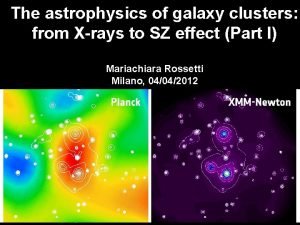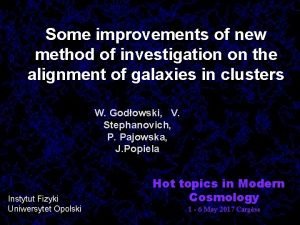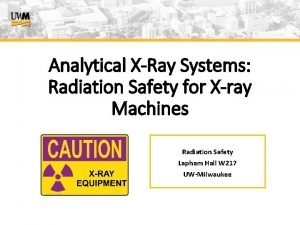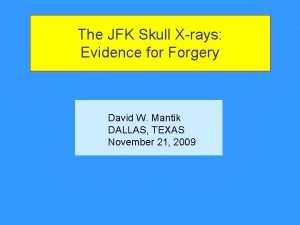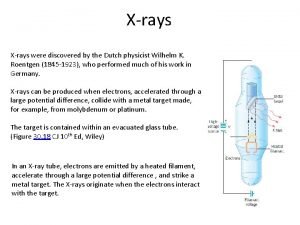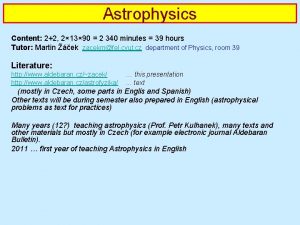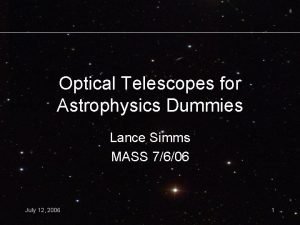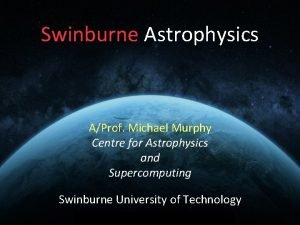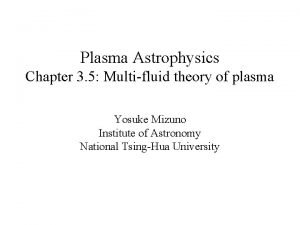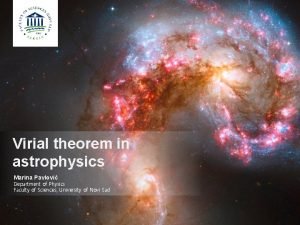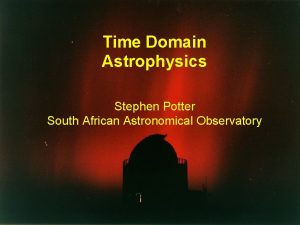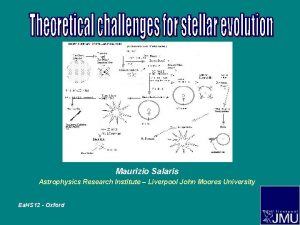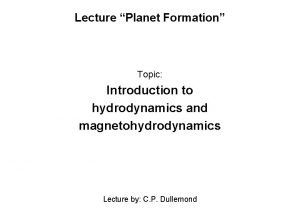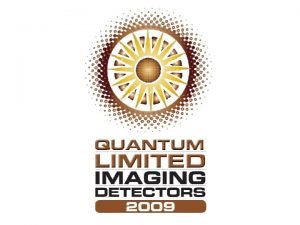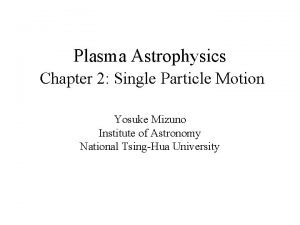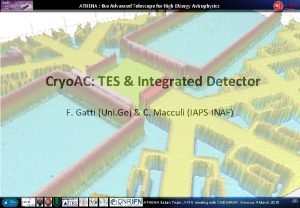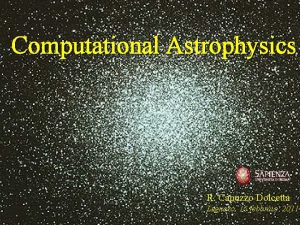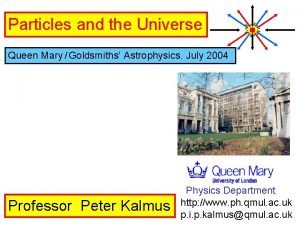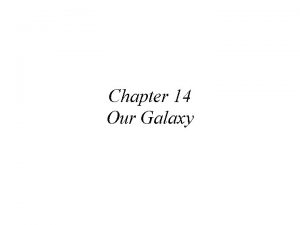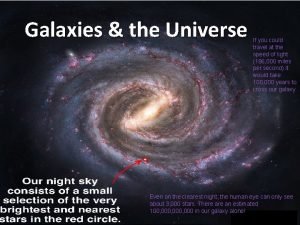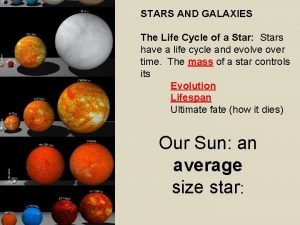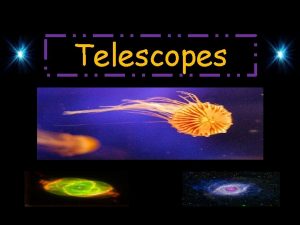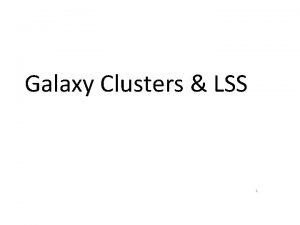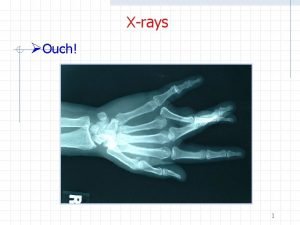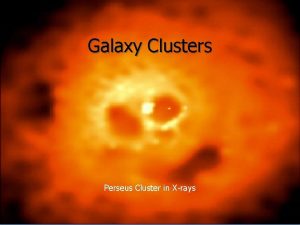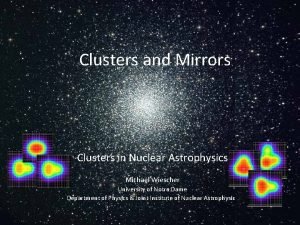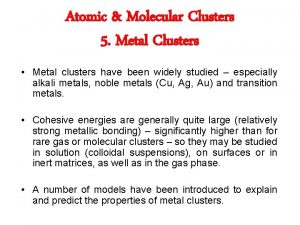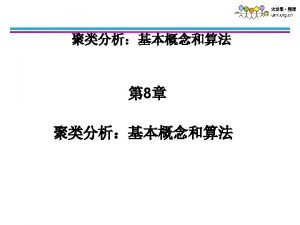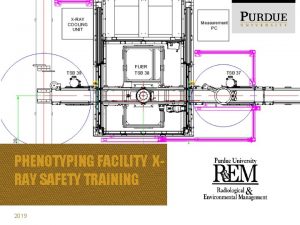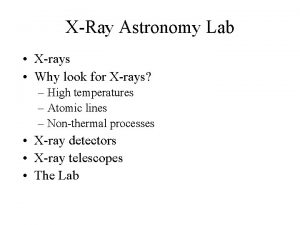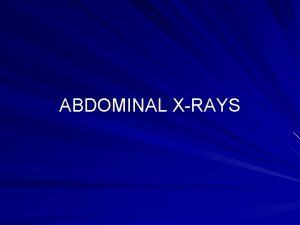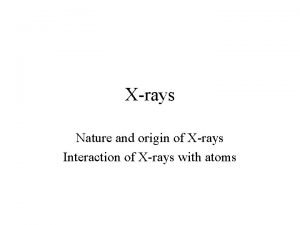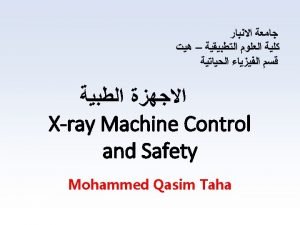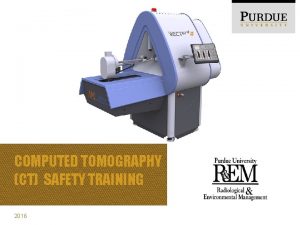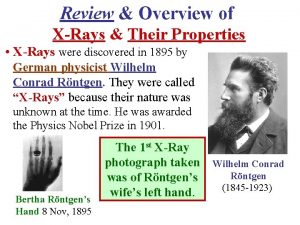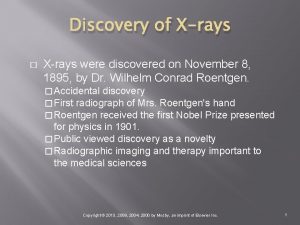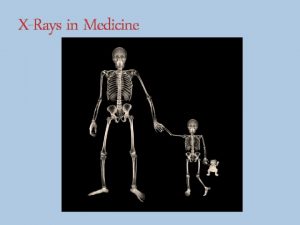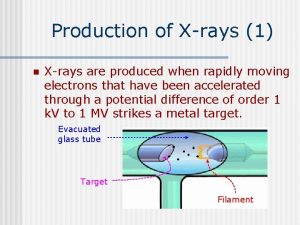The astrophysics of galaxy clusters from Xrays to

























- Slides: 25

The astrophysics of galaxy clusters: from X-rays to SZ effect (Part I) Mariachiara Rossetti Milano, 04/04/2012

GALAXY CLUSTERS: WHAT? Intra-cluster medium (ICM) X-rays (10 -30%) Galaxies (5%) Dark Matter Gravitational potential 1 E 0657 -156 THE BULLET CLUSTER Galaxy clusters are the most massive (M~1014 -1015 MSUN) objects in the Universe

Galaxy clusters: why? Galaxy clusters as cosmological tools Rosati et al. (2002) Vikhlinin et al. (2009)

Galaxy clusters: why? • Galaxy clusters as astrophysical objects

Galaxy clusters: how? The ICM is the dominant baryonic component of GC. Hot (107 -108 K) and low density (10 -2 -10 -4 cm-3) plasma, ionized H, enriched with metals Thermal bremsstrahlung emission in X-rays Galaxy clusters are extended (˜Mpc) and bright (1043 -1045 erg/s) sources in X-rays The Coma Cluster as seen by ROSAT PSPC

Galaxy clusters: how? The ICM is the dominant baryonic component of GC. Hot (107 -108 K) and low density (10 -2 -10 -4 cm-3) plasma, ionized H, enriched with metals Sunyaev Zel’dovich effect in mm/submm Galaxy clusters are “extended” (˜Mpc) and prominent secondary anisotropies of the CMB, with a unique spectral signature The Coma Cluster as seen by Planck

X-ray emission of galaxy clusters X-ray spectral analysis allows us to measure the temperature and the density of the ICM. Spatially resolved analysis: 1 D and 2 D distribution of thermodynamic quantities of the ICM

X-ray emission of galaxy X-ray surface brightness clusters at distance b b Isothermal beta model ß=0. 67 X-ray surface brightness drops quickly! r OSSERVATORE

Most of the info from center regions ~0. 25 r 180 = 12. 3’ 2. 5 Mpc r 180 Notation: R marks the radius within which the mass density is times the critical density c(z) R 180=virial radius ( m=1) Abell 963 z = 0. 206 k. T = 7. 4 ke. V rmax = 6’ 1. 2 Mpc 50% r 180 ≈R 500 Abell 963 EPIC XMM-Newton 0. 4 -2. 0 ke. V

OUTER REGIONS Inner regions sou >> bkg Outer regions sou bkg

Background + Source model (XMM-Newton) NXB= instrumental background (particles + fluorescent lines ) QSP= variable instrumental component (solar soft protons) CXB= Cosmic X-ray background (unresolved point sources) Halo = galactic foreground emission X-ray measurements in clusters outskirts require a detailed background modeling and a careful treatment of systematics

Existing and future(? ) X-ray observatories are not suited for studying extended faint emission. Requirements: Low equatorial orbit to reduce particle background and good angular resolution to resolve CXB. Possibly dedicated observational strategy Orbit Resolution XMM-Newton (ESA) High elliptical orbit 6 arcsec Chandra (NASA) High elliptical orbit 0. 5 arcsec Athena (ESA 2024? ? ? ) L 2? ? ? ? 5(goal)-10(baseline) arcsec Suzaku (JAXA) Low equatorial orbit 1. 8 arcmin WFXT (R. I. P. ) Low equatorial orbit 5 arcsec

The Sunyaev-Zel’dovich (SZ) effect Distorsion in the CMB spectrum due to Inverse Compton scattering of CMB photons with electrons of the ICM • Thermal SZ • Kinetic SZ • Relativistic SZ

The Sunyaev-Zel’dovich (SZ) effect The thermal SZ has a unique spectral signature (independent on the cluster properties)

The Sunyaev-Zel’dovich (SZ) effect The thermal SZ has a unique spectral signature (independent on the cluster ICM thermal properties) pressure

The Sunyaev-Zel’dovich (SZ) effect • The integrated SZ signal is proportional to the total mass (cosmology!) • The spectral distortion caused by SZ is redshift independent (an efficient way to find clusters)

The SZ effect with Planck ü Unique band coverage (on both sides of the spectrum ) ü All sky survey (allows detection of the rarest objects) X Moderate spatial resolution • 5 Early papers (early catalogue and properties) • 2 published Intermediate papers (validation and high z massive cluster) • 7 Intermediate papers on astrophysics of galaxy clusters(stay tuned) • Cosmology papers and final catalogue

The SZ effect with Planck A 2256 (S/N = 28) Raw maps Planck Collaboration 2011 Typical SZ sources are barely visible in raw frequency maps: need adapted technique to find clusters. Matched Multi Filter Algorithm MMF 3 (Melin et al 2006) enhances SZ signal over other components: • known spectral signature • known spatial shape Universal pressure profile: predicted dark matter distribution from simulations (Navarro, Frenk & White 95, Nagai et al 07) Parameters estimated from a X-ray sample (Arnaud et al 2010) This is for blind SZ detection (YSZ), for known cluster (or with follow-up Xray observations) we can estimate the SZ signal using X-ray priors, e. g. position, size (Y 500)

The SZ effect with Planck A 2256 (S/N = 28) Raw and CLEAN maps Planck Collaboration 2011 Use component separation technique to clean the maps. Several methods based on Internal Linear Combination (MILCA, Hurier et al 2010): removal of thermal dust, radio and IR sources, and of the CMB. Reconstruction of SZ y-maps: 2 D distribution of the SZ signal and of thermodynamic properties of the ICM As with X-rays? Yes, but after smoothing with a 10 arcmin beam

SZ effect vs X-rays? r 180 rmax Planck allows to map the ICM up to the virial radius and beyond! At least for nearby massive objects “Where no man has gone before” (P. Mazzotta, Planck Conference 2012) Clusters outskirts

The Coma Cluster ROSAT PSPC MOSAIC 5 degrees But Planck can also see finer details on Coma (P. Mazzotta, Planck Conference 2012) “Shocking News” coming soon! The Coma Cluster is the closest (z=0. 022) massive hot (k. T=8 ke. V) cluster: ideal for SZ studies It is spatially resolved by Planck (10 arcmin=260 PLANCK Y-MAP kpc)

SZ effect vs X-rays? Cluster Cosmology: need an unbiased way to find clusters and measure their masses Planck Collaboration (2011): Discovery of a massive luminous cluster at z≈1 BUT relies on follow-up observation for measuring redshift and size

SZ effect vs X-rays? Cluster Cosmology: need an unbiased way to find clusters and measure their masses Planck Collaboration (2011): Good low-scatter correlation between integrated SZ signal and total mass BUT relies on follow-up observation for measuring redshift and size

SZ effect vs X-rays? SZ effect can be measured also from earth. Already many existing instruments: SPT, ACT, APEX SZ, Bolocam, AMI, Mustang… Technology quickly improving: SPTpol, ACTpol, CCAT… Very active field!

SZ effect vs X-rays? X-ray astronomy is accessible and “easy” (first approximation): public data after 1 yr proprietary period, public data analysis software, standard procedures SZ observations are not: proprietary data and software. You have to be in collaborations. SZ effect with X-rays! X-rays and SZ are complementary. 6 PIP on galaxy clusters are obtained combining X-rays and SZ
 Irregular galaxy
Irregular galaxy Galaxy clusters
Galaxy clusters Galaxy clusters
Galaxy clusters Galaxy clusters
Galaxy clusters Who discovered xrays
Who discovered xrays Jfk xray
Jfk xray How were xrays discovered
How were xrays discovered Frequency of xrays
Frequency of xrays Nasa astrophysics advisory committee
Nasa astrophysics advisory committee 13,90/2
13,90/2 Astrophysics for dummies
Astrophysics for dummies Swinburne astrophysics
Swinburne astrophysics Astrophysics equations
Astrophysics equations Virial theorem in astrophysics
Virial theorem in astrophysics Time domain astrophysics
Time domain astrophysics Liverpool astrophysics
Liverpool astrophysics Mhd equations
Mhd equations Rit astrophysics
Rit astrophysics Astrophysics
Astrophysics Advanced telescope for high energy astrophysics
Advanced telescope for high energy astrophysics Astrophysics
Astrophysics Queen mary astrophysics
Queen mary astrophysics Type of galaxy
Type of galaxy Why do disk stars bob up and down as they orbit the galaxy?
Why do disk stars bob up and down as they orbit the galaxy? Are the stars we see at night in our galaxy
Are the stars we see at night in our galaxy Life cycle of galaxies
Life cycle of galaxies

